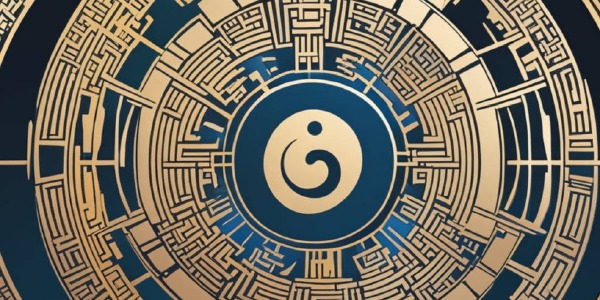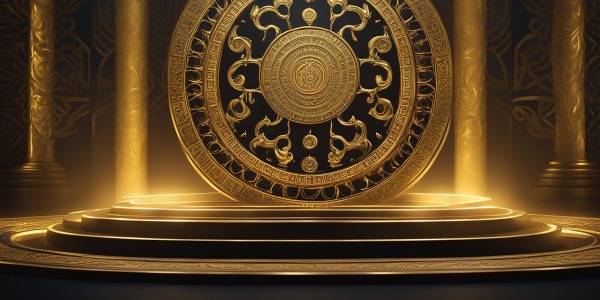The Mandala and the Gods: Exploring Divine Symbols in Sacred Art
Mandalas, intricate spiritual and ritual symbols in Hinduism and Buddhism, serve as tools for meditation, representing the universe and various divine deities. These complex geometric designs transcend simple artistic expression, offering a profound journey into self-discovery and universal understanding. The presence of gods within these cosmic diagrams underscores the importance of deities in mandala art, where each figure embodies a specific aspect of the spiritual journey. Mandala art isn’t solely confined to religious context; it also holds considerable significance in various cultures as a symbol of harmony and wholeness.
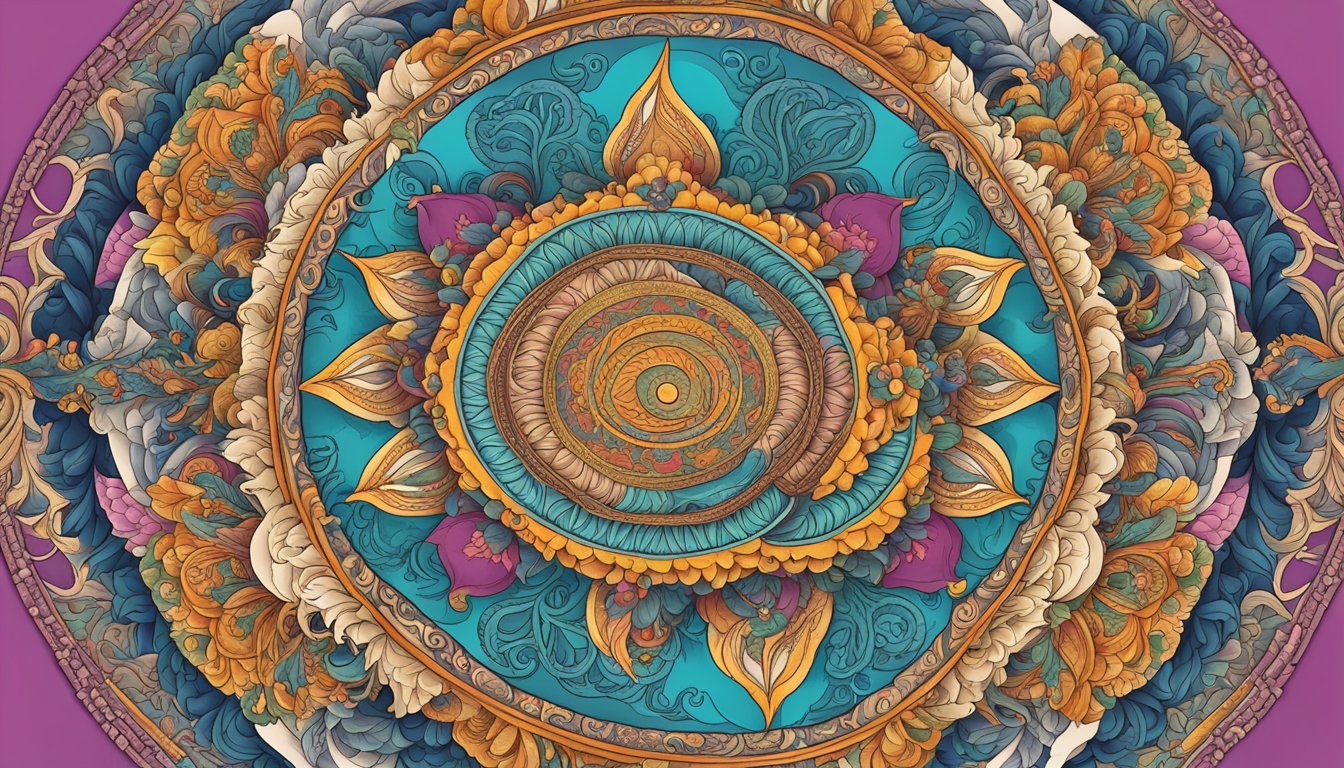
The creation and usage of mandalas are steeped in tradition, with each shape, color, and arrangement contributing to its deeper symbolic meanings. Deities depicted within mandalas are more than mere artistic subjects; they are integral to the spiritual narrative and practice, often serving as focal points for meditation and reflection. As mandala art has evolved, it has come to influence modern expression across cultures, retaining its importance in spiritual practice while also adapting to contemporary art forms. The fusion of the ancient with the modern reflects the enduring relevance of these sacred circles and the gods they house.
Key Takeaways
- Mandalas represent the universe and are intertwined with spiritual practices and meditation.
- Deities within mandalas symbolize various facets of spirituality and are central to the artwork’s narrative.
- While rooted in tradition, mandala art continues to influence modern culture and artistic expression.
Origins and History
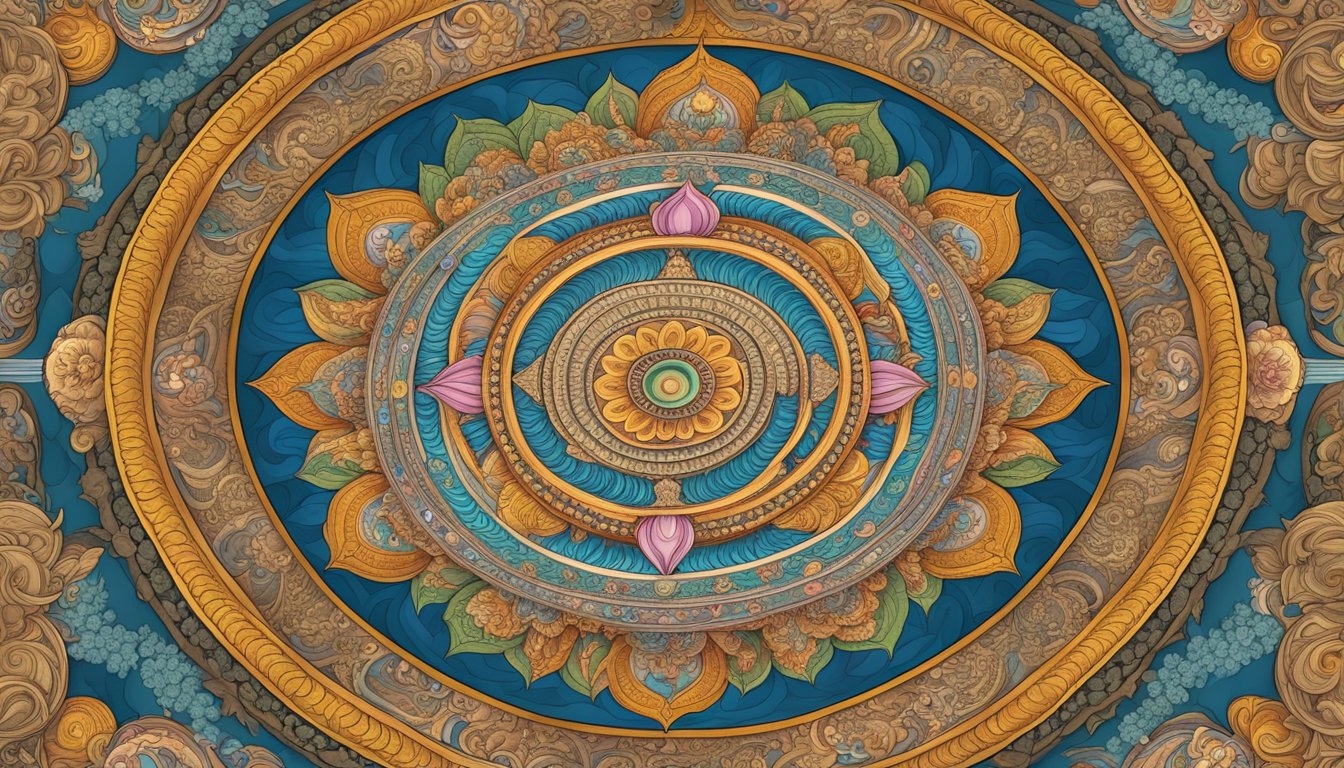
The origins of mandala art trace back to ancient traditions, deeply rooted in spiritual practices and the spread of Buddhist teachings. While the mandala began as a sacred form in India, its evolution has been marked by a significant expansion to East Asia and an eventual global influence, coloring both art and psychology.
Cultural Roots in India
Mandalas originated in India, with their name derived from the Sanskrit word for “circle.” In the context of Buddhism and Hinduism, mandalas have been used as meditative tools and spiritual symbols that represent the universe. They embody a profound meaning in Tibetan Buddhism, where monks create intricate sand mandalas that symbolize the impermanence of life.
Expansion to East Asia
The transmission of Buddhism from India along the Silk Road facilitated the spread of mandalas into China and subsequently to Japan. Each culture adapted the concept to its traditions, integrating local symbols and styles. In China, they became key components in meditative practices, while in Japan, particularly within the Shingon sect of Japanese Buddhism, mandalas evolved into intricate paintings used for contemplation and rituals.
Global Influence and Carl Jung
Mandalas eventually transcended their religious origins, catching the attention of Western cultures during the 20th century, notably through the work of Swiss psychiatrist Carl Jung. He interpreted mandalas as a representation of the subconscious and incorporated them into his analytical psychology as tools for personal growth and understanding of the psychological self. Jung’s influence popularized mandalas beyond their initial contexts, leading to widespread recognition of their value in fostering mental balance and well-being in Western culture.
Understanding Mandalas
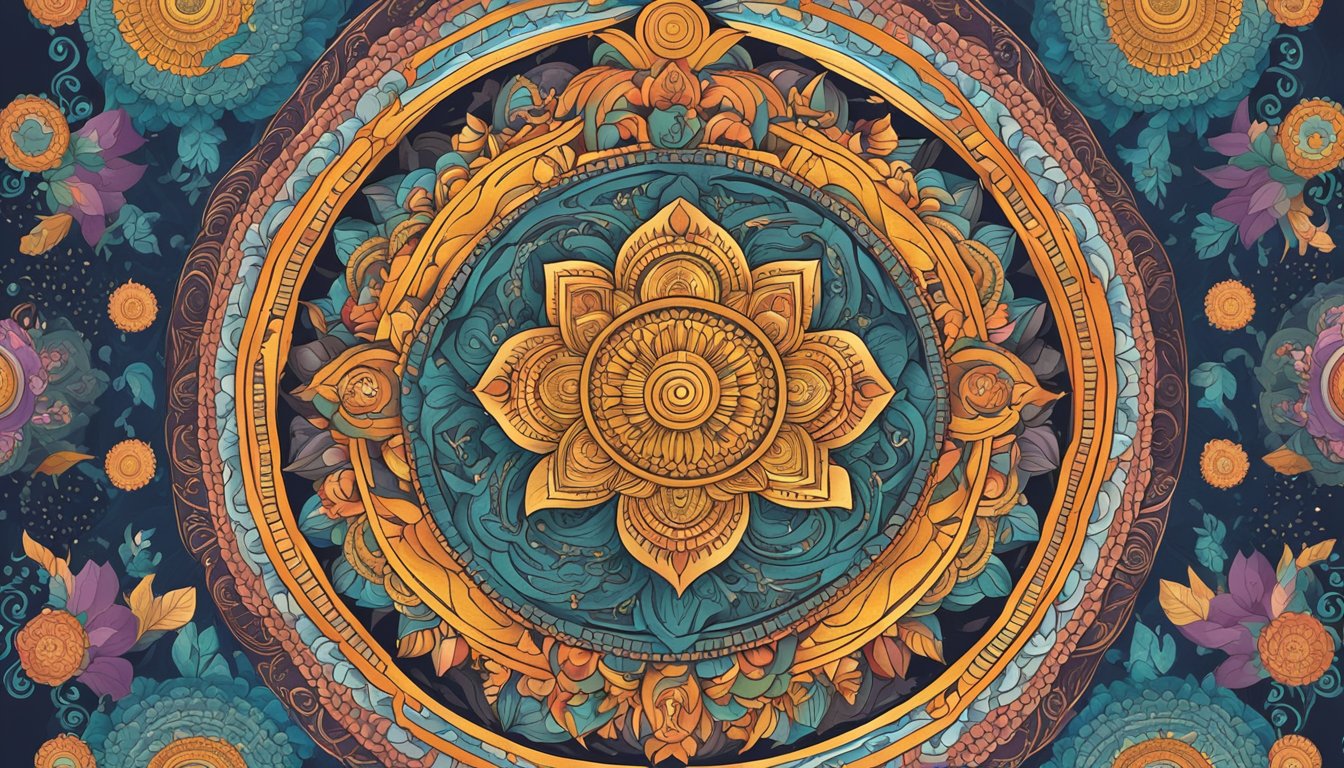
Mandalas are intricate visual representations that are rich in symbolism and have a deep connection with spirituality and meditation.
Definition and Etymology
A mandala is a geometric configuration of symbols, typically circular in form and often integrating a square with four gates. The term mandala is derived from the ancient Sanskrit language, wherein ‘mandala’ simply means circle. A circle symbolizes unity, wholeness, and infinity, encompassing the essence of mandalas which are often seen as diagrams of the cosmos.
Symbolism and Representation
In Tibetan Buddhism, mandalas are sacred and hold immense symbolic significance. They are regarded as an abode of deities and a collection place for the gods themselves. Each segment of the mandala is symmetrical, demonstrating a universe that is orderly and balanced. Mandalas serve as a visual aid for concentration and introspective meditation, with the patterns leading the viewer’s mind towards the center of the disc — a journey from the outer world to inner enlightenment.
Types and Variations
Mandalas take many forms depending on their cultural and spiritual origins. Here’s a concise list illustrating some types and variations:
- Hindu and Buddhist Mandalas: Typically used in rituals and ceremonies. They can be painted, drawn, or created with colorful sand.
- Yantras: These are Tibetan Buddhist mandalas in the form of amulets, often bearing complex designs intended for meditation.
- Sand Mandalas: Particularly in the Tibetan tradition, these are created with colored sand and are ritually dismantled, representing the impermanence of existence.
Each type of mandala carries its unique blend of aesthetics and spiritual significance, tying back to the common threads of unity and self-reflection found across various practices.
Mandala Elements and Design
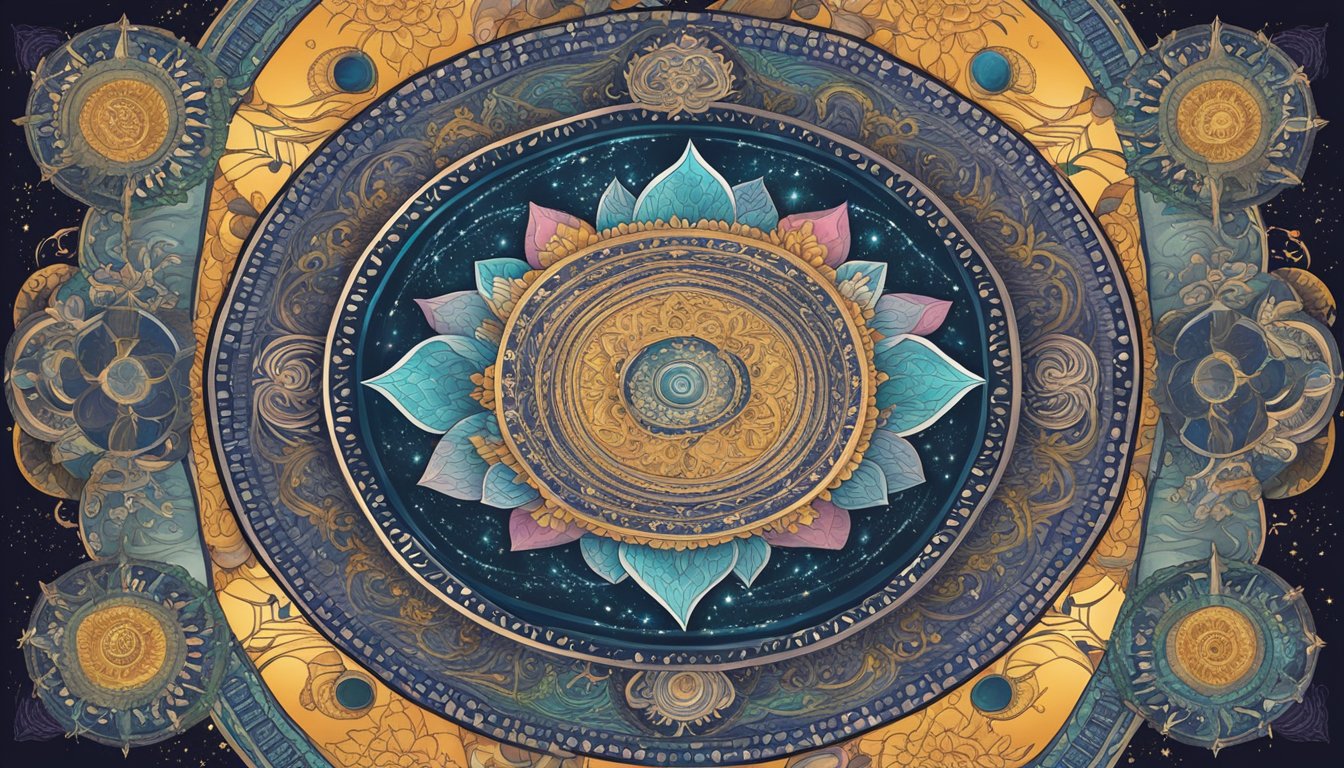
The intricate elements and design in mandala art incorporate specific shapes, a vibrant palette of colors, and symbolic representations of deities. This visual harmony is believed to aid in meditation and spiritual guidance.
Shapes and Geometry
Mandalas are characterized by their geometric patterns that often include circles and other shapes radiating from a central point. These geometric configurations are usually symmetrical, reflecting balance and unity. The central point commonly symbolizes the starting point of contemplation or the presence of a central deity. For instance:
- Circles: Represent the notion of eternity and wholeness.
- Squares: Symbolize the earth and grounded stability.
The Use of Color
Color in mandalas is not only aesthetically pleasing, but also carries significant symbolism. Pigments and colored sand are meticulously chosen to represent different aspects of enlightenment and spiritual concepts. The colors are often bold and vibrant, with each hue signifying a particular attribute:
| Color | Significance |
|---|---|
| Blue | Infinity and purity |
| Red | Power and passion |
| Yellow | Enlightenment and wise decisions |
| White | Purity and simplicity |
| Black | Mystery and deep thinking |
Incorporating Deities
Deities in mandala art represent various facets of spiritual teachings and are often integral to the mandala’s meaning. Positioned strategically within the design, they are either represented symbolically through shapes or depicted explicitly. Key elements include:
- Central Deity: Usually placed at the mandala’s center, symbolizing the essence of the cosmos.
- Bodhisattvas: Compassionate beings found within the art, promoting the welfare of others.
Each deity within the mandala is carefully chosen for the spiritual message the piece is intended to convey and is depicted with corresponding symbols and colors to enhance the overall sacred experience.
Symbolic Meanings
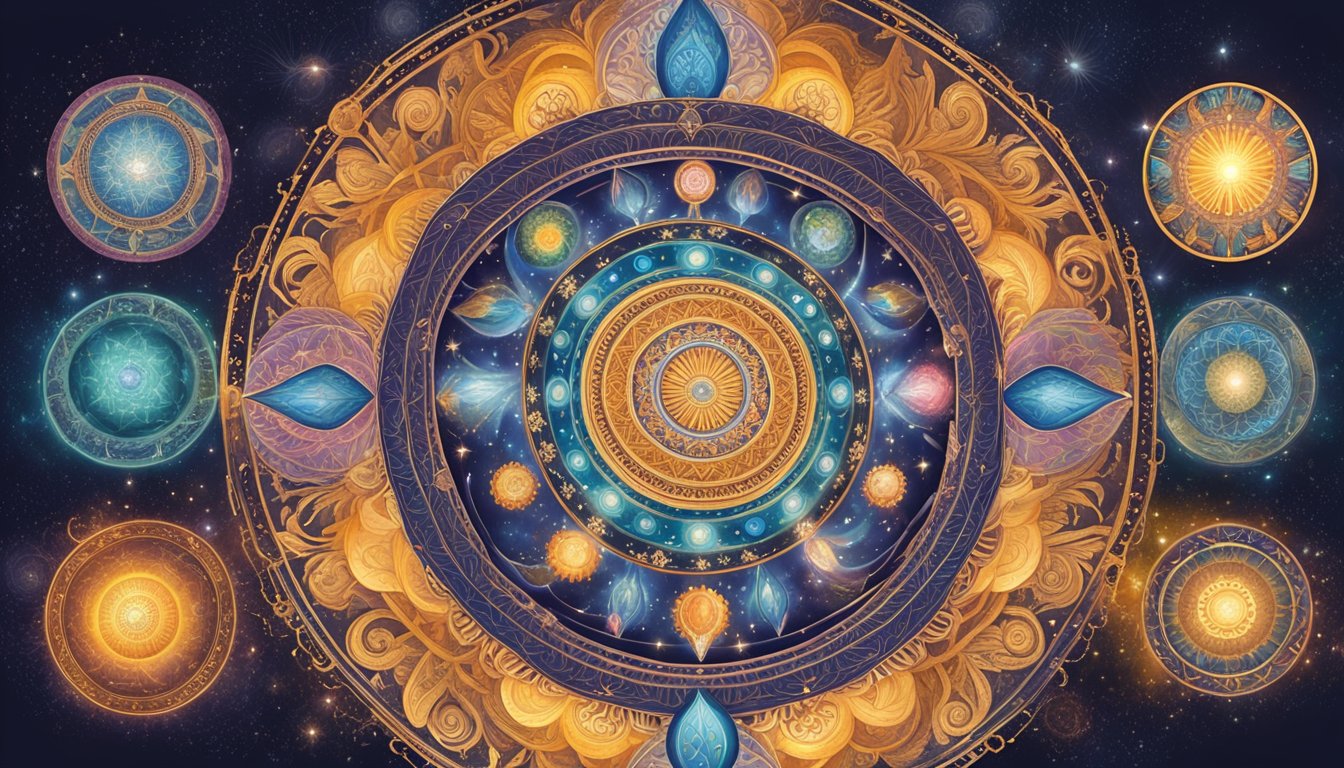
In mandala art, each design element and color holds a profound significance, revealing layers of psychological and spiritual truths, often reflecting the vastness of the cosmos and the inner workings of the mind.
Cosmic and Psychological Significance
Mandalas serve as tools for meditation and symbols of spiritual journey for individuals seeking self-awareness and cosmic truths. In the Tibetan cosmology, mandalas are spiritual maps that guide the meditator towards enlightenment, signifying both the microcosm of the universe and the inner landscape of the psyche.
Representation of The Universe
The Hindu mandala, exemplified in its intricate geometric patterns, usually represents the cosmos metaphysically or symbolically. It showcases the universe as an orderly and harmonious system—where each part reflects the whole—echoing the notion that individual lives are part of a greater, interdependent cosmic dance.
Life Lessons and Impermanence
In mandala art, the intricate and ephemeral nature is a powerful teacher of impermanence. Creation of mandalas, especially in sand form, and their subsequent destruction, reflects the Buddhist belief in the transitory nature of life. This practice promotes awareness and acceptance of change, as one acknowledges that life’s lessons are often amidst constant evolution.
Mandalas in Religious Practices
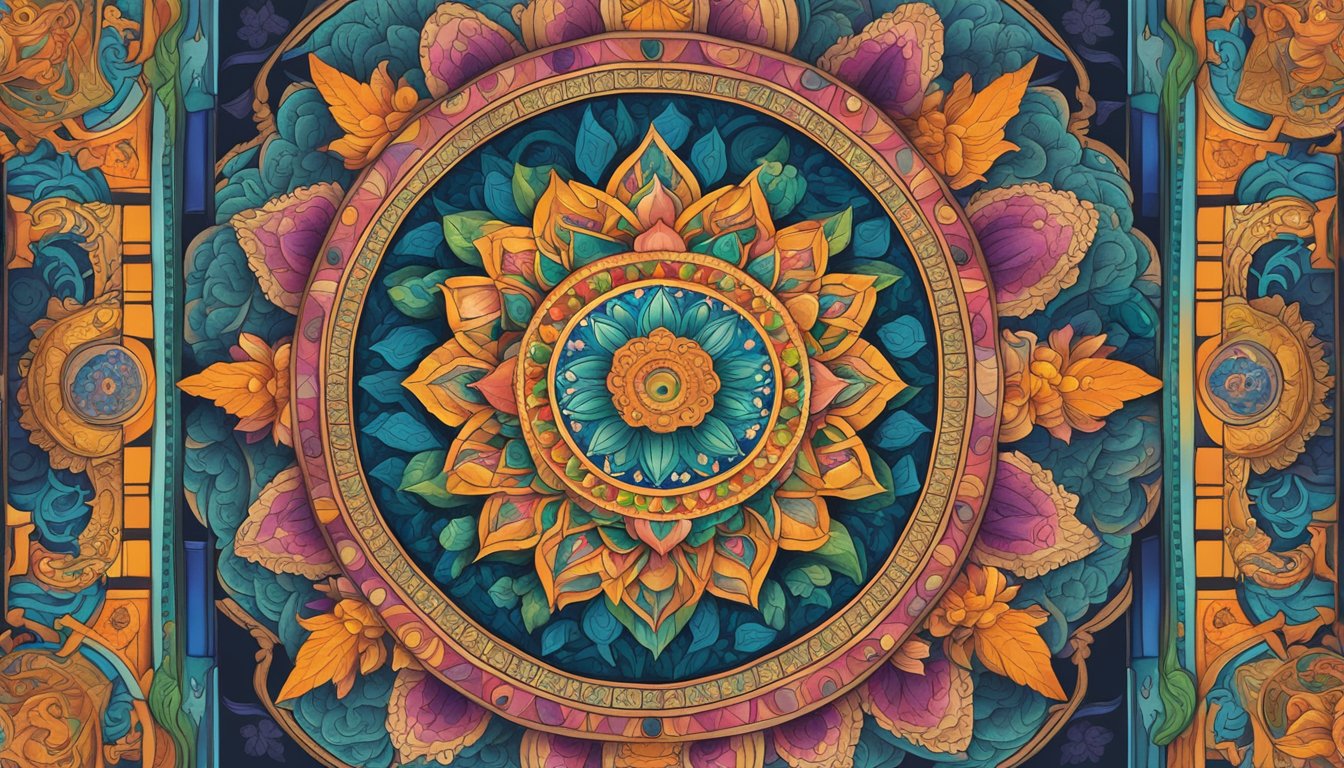
Mandalas serve as spiritual symbols in various religious practices, often representing the universe, and are used as tools for meditation, ritual, and the embodiment of spiritual truths.
Buddhism and Meditation
Mandalas hold significant importance in Buddhism, particularly within tantric meditation practices. They represent the universe and serve as visual aids for focusing attention. Monks create intricate mandala designs using colored sand to facilitate meditation, with each design reflecting lessons from the Buddha. During the meditative process, practitioners are encouraged to internalize the cosmic symbolism of the mandala, guiding them toward spiritual enlightenment.
Hindu and Jain Rituals
In Hinduism, mandalas are known as yantras and are used in various rituals to embody different deities or cosmic forces. These geometrical designs are essential in tantra practices, where each detail of the yantra is deeply symbolic and often incorporates key concepts of mantras or sacred sounds. Similarly, Jainism utilizes mandalas during spiritual rites, reflecting its principles of cosmic truths and pathways to enlightenment.
Beyond Eastern Traditions
While mandalas are closely associated with Eastern religions, analogous symbols can be found in other traditions such as Shinto, Christianity, and Celtic heritage. In Shinto, similar emblematic designs are used in shrines as a representation of the universe. The Celtic cross, with its intricate knots and circular motif, shares visual similarities with the mandala, symbolizing eternity and the interconnectedness of life. In Christianity, the rose windows of cathedrals serve as mandala-like symbols, expressing the universalizing aspect of Christian cosmology and faith.
Creation and Usage
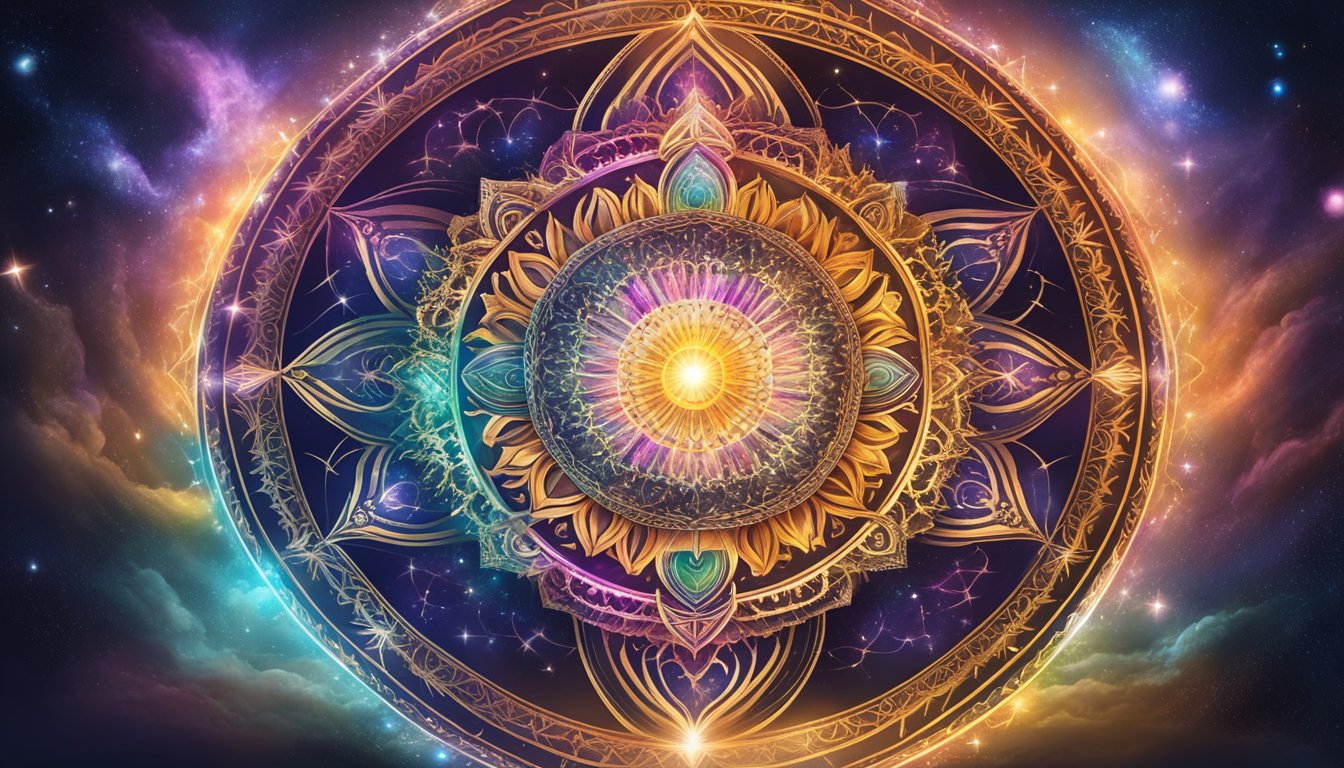
The crafting of mandalas is a meticulous process, often intertwined with spiritual and religious practices. They serve not only as sacred offerings but also as instruments of meditation and channels for self-acceptance.
Traditional Making Techniques
The creation of mandalas, especially those made of sand, involves precise traditional techniques passed down through generations. Monks initiate the process by consecrating the site, creating a sacred space where the mandala will emerge. They use metal funnels called chak-pur to lay down the colored sand with extreme care. As the mandala takes shape, each grain of sand is purposefully placed, often invoking spiritual guidance during the process.
Materials used in traditional mandala creation:
- Colored sand: For vibrant, intricate patterns
- Ink: For outlining initial designs
- Metal funnels (chak-pur): For precise application of sand
Sacred Rites and Offerings
Mandalas are central to various rites and ceremonies. Their creation is typically accompanied by rites that may include chanting, music, and prayer, amplifying the spiritual atmosphere. Once completed, the mandala becomes an offering, symbolizing impermanence as many traditions dictate that the sand be swept up and dispersed after a ceremony, returning the sand to nature.
Key aspects of mandala ceremonies:
- Incorporation of ritual chants and music
- Presence of spiritual leaders for guidance
- Concluding offering rites where the mandala is dismantled
Contemporary and Therapeutic Use
In contemporary settings, mandalas extend beyond religious contexts, often employed as a meditative tool. Therapists may use mandala creation to promote self-acceptance and psychological healing. People find comfort in the repetitive, focused act of creating mandalas, which can provide a therapeutic sense of peace and wholeness.
Modern uses of mandalas:
- As a therapeutic aid in counseling
- Meditative tool for stress reduction
- Art therapy for enhancing self-acceptance and personal growth
Deities in Mandala Art
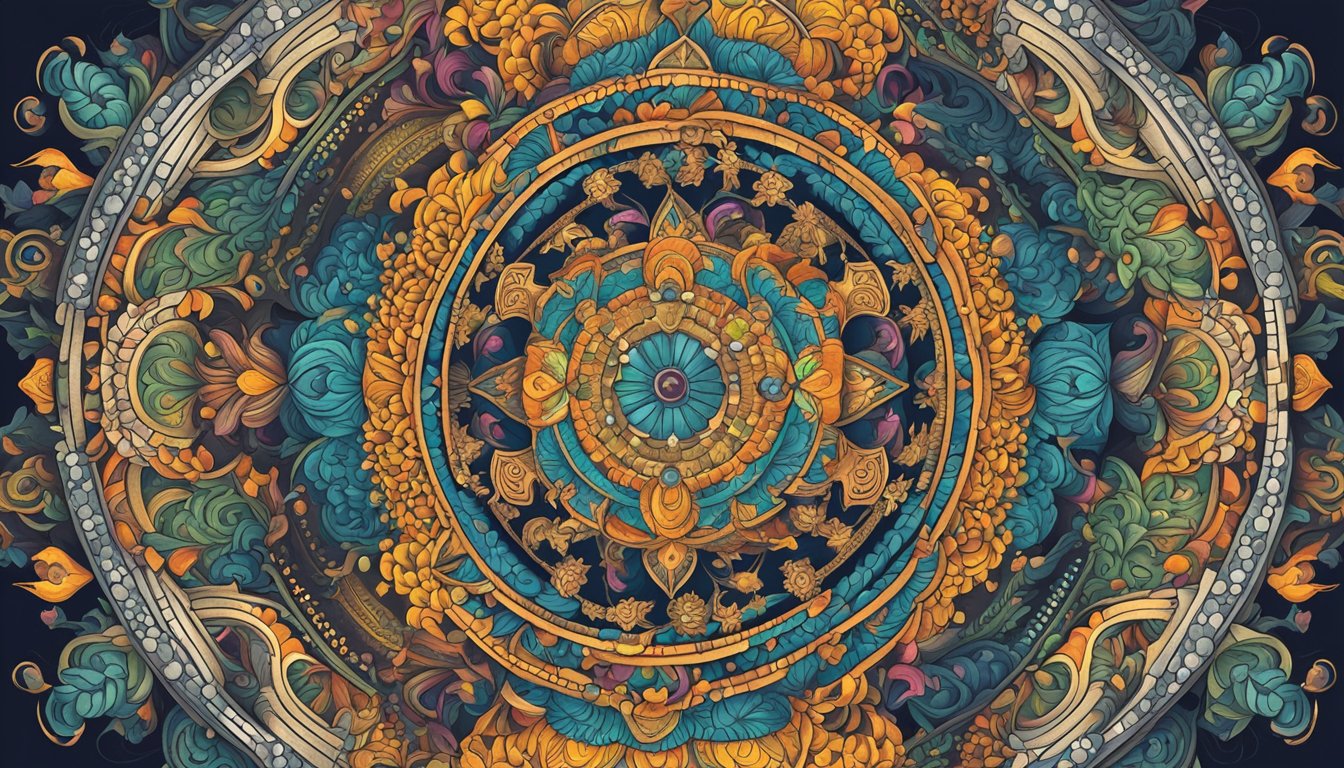
Mandala art is rich with symbolic representations, with various deities and bodhisattvas being central to its iconography. These figures are integral to understanding the art’s deeper meanings, which often relate to spiritual teachings and practices.
Major Deities and Bodhisattvas
In mandala art, a variety of deities are depicted, each embodying different aspects of the cosmos and spiritual teachings. Buddha figures frequently appear, representing enlightenment and ultimate wisdom. The presence of bodhisattvas, such as Avalokiteshvara (the embodiment of compassion) and Manjushri (symbolizing wisdom), serves to inspire compassion and insight. These deities and beings are often arranged in accordance with their importance and attributes.
- Avalokiteshvara: Compassion
- Manjushri: Wisdom
- Vajrapani: Power
The Role of the Central Deity
The central deity in mandala art holds a fundamental position, acting as a focus for meditation and reflection. This key figure symbolizes the ultimate reality and is essential in guiding the observer toward the contemplation of profound truths about existence and samsara, the cycle of life and rebirth. In Tantric practices, the central deity can also serve as an embodiment of specific transcendent qualities that practitioners aspire to attain.
Iconography and Meanings
The iconography in mandala art is multi-layered, with symbols and deities representing facets of the spiritual journey. Each figure and symbol is meticulously chosen to convey specific teachings and concepts.
- Lotus: Purity and spiritual unfolding
- Wheel: The teachings of the Buddha (Dharma)
- Thunderbolt (Vajra): The firmness of spirit
Through the specific arrangement and details within the mandala, artists encode teachings about the universe, the nature of existence, and the path to enlightenment. The transformative potential of these symbols is activated in the context of ritual and meditation, providing a visual language for complex spiritual concepts.
Modern Expression and Influence
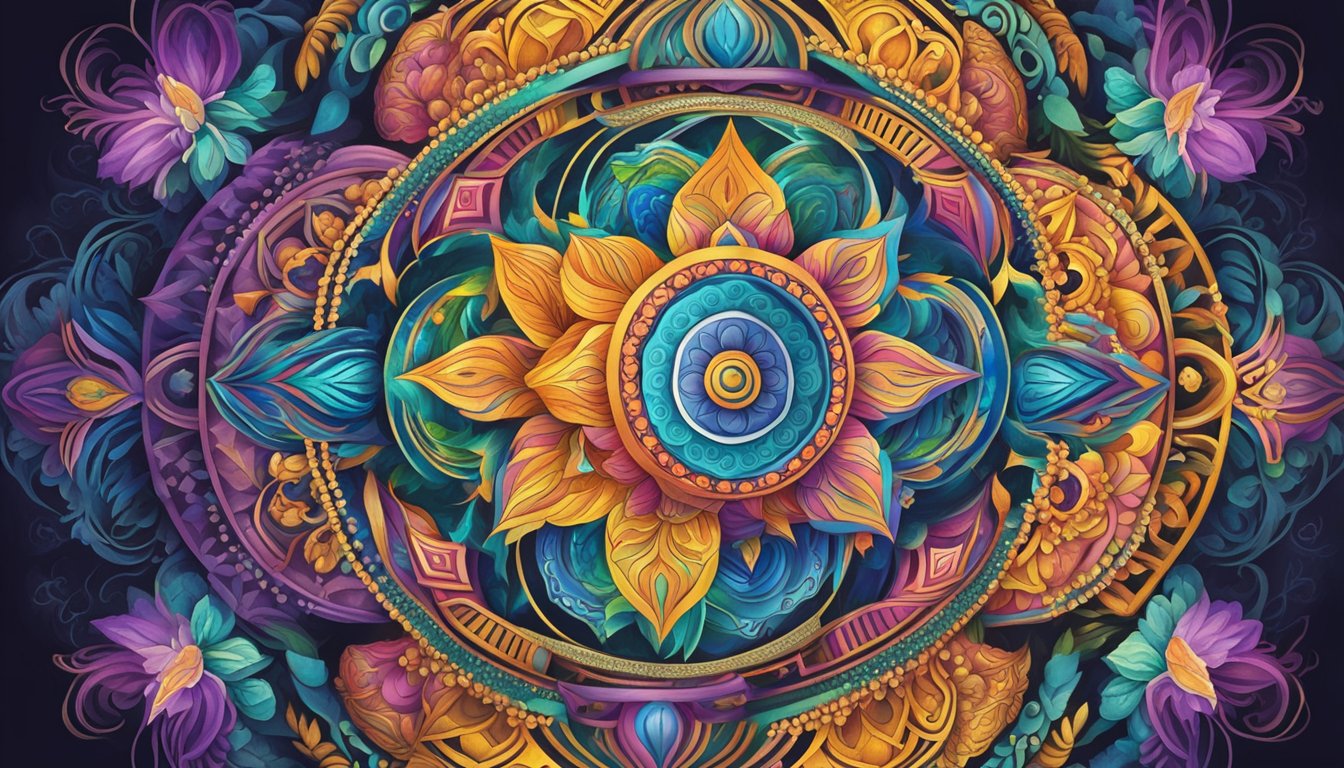
In recent years, mandalas have transcended traditional boundaries, embedding themselves into various facets of modern life. From their use in contemporary art to the design of spaces that promote tranquility, mandalas continue to serve as a bridge between the spiritual and the everyday.
Pop Culture and Art
Mandalas have woven their way into pop culture with a vibrant presence in art and media. They often appear in colorful artwork, adorn book covers, and feature in the backgrounds of popular television shows and films, showcasing intricate craftsmanship. Artists may integrate mandala patterns into graffiti, fashion, and digital illustrations, highlighting their geometric beauty and contemporary relevance.
- Examples in Media:
- Illustrated album covers
- Background designs in animated movies
Mandalas in Mindfulness and Healing
Mandalas are significant in mindfulness practices and mental health therapies. They are utilized as meditative tools that facilitate concentration and provide spiritual guidance. In coloring books and therapy sessions, creating or filling in mandalas with various hues is believed to help center the mind and promote a sense of inner peace.
- Uses in Healing:
- Adult coloring books focusing on mandala patterns.
- Guided meditation sessions employing mandala imagery.
Architecture and Sacred Spaces
The principles of the mandala have influenced the design of temples, palaces, and modern sacred spaces. Architects draw inspiration from mandalas to create environments that reflect balance and harmony. The use of concentric layouts in places like restorative gardens or modern spiritual centers underlines the enduring legacy of mandalas in creating poignant and peaceful atmospheres.
- Architectural Manifestations:
- Temple grounds arranged to reflect cosmic harmony.
- Public parks and gardens with mandala-inspired landscapes.
Frequently Asked Questions
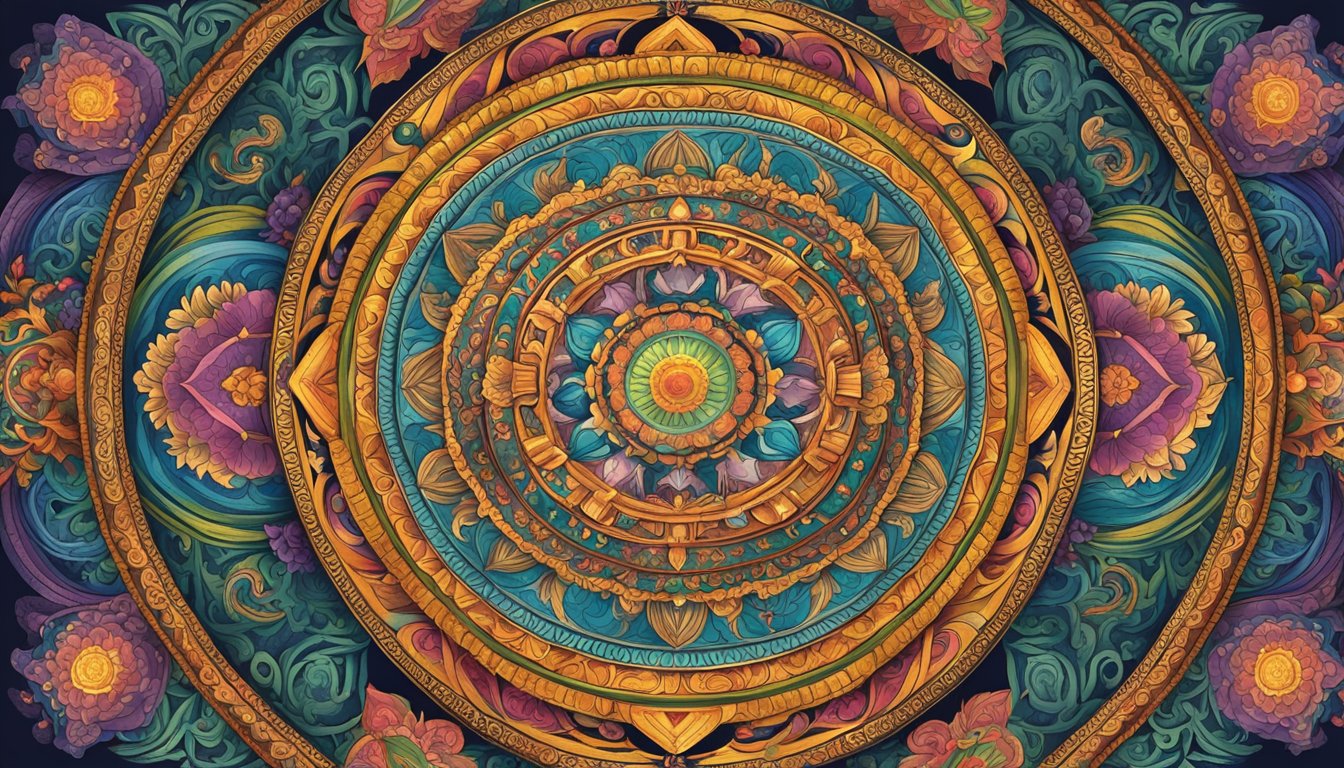
In this section, readers can find answers to common inquiries about the incorporation of deities in mandala art, understanding its creation process, and learning about the symbolism and healing aspects it offers.
What is the significance of deities within mandala art?
Deities in mandala art represent various attributes and are often symbolic of higher spiritual truths and principles. They serve as focal points for meditation and reflection, guiding individuals in their spiritual journey.
How can beginners get started with creating their own mandala art?
Beginners can start by learning basic geometric patterns and symbols, and gradually incorporate more complex designs. Various resources, such as online tutorials and workshops, can provide guidance on techniques and materials needed.
What are the healing properties associated with mandala art?
Mandala art is believed to promote relaxation, focus the mind, and facilitate meditation. It can help alleviate stress and anxiety, allowing individuals to explore their inner selves and find a sense of peace.
Can you explain the process of creating a sand mandala?
Creating a sand mandala involves carefully placing colored sand grain by grain to form intricate patterns. This process is meditative and precise, typically carried out by Tibetan monks as a ritual that symbolizes impermanence and the cycle of life.
What does the lotus symbol represent in mandalas?
The lotus symbol in mandalas is often associated with purity, spiritual awakening, and enlightenment. It represents the journey from the murky waters of materialism to the bright surface of self-realization.
What are some common symbols found in mandalas and their meanings?
Symbols such as the wheel, representing the cycle of life; the bell, denoting wisdom; and the thunderbolt, symbolizing compassion, are common in mandalas. Each shape, color, and line can hold a variety of symbolic meanings, depending on the context and tradition.

